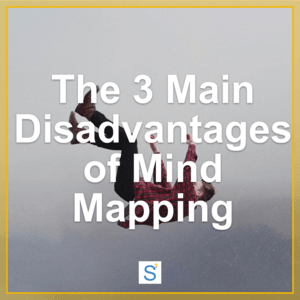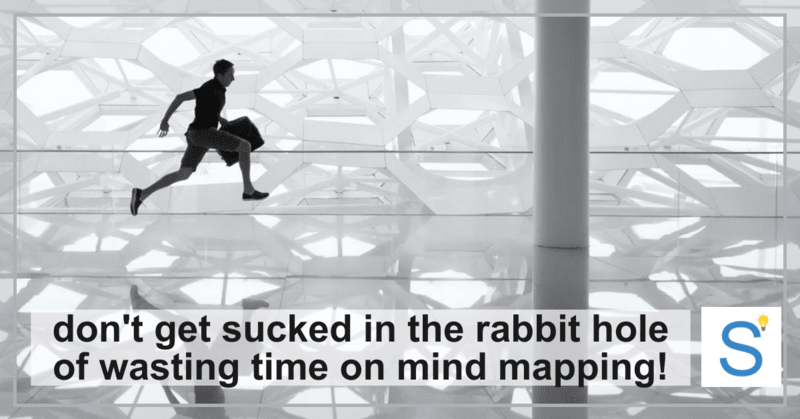You may have looked into mind mapping before. You may even have used mind maps for work or study. Chances are you stopped using them for one of these three reasons: time, effort, or fear.
This doesn’t mean mind mapping is bad or doesn’t work. It is just a matter of you not having used it more productively.
Understanding what can go wrong, will be a major step towards learning to use mind mapping the right way.

Let’s start with…
Mind mapping takes too much of your time

Mind mapping can be like YouTube. Once you click that first video, you are sucked in, and before you know it one hour has passed.
Mind mapping does this by letting you think you can make your work look better, prettier, or simply clearer. And while this is something that is often true, you shouldn’t focus on all of this. Especially in the beginning when you first created the outline of your book.
A good mind map is not the result of making the map look better. You should remember that the best mind map is the one that shows you your information in the best possible outline. This outline will change due to learning new things. Small tweaks, like (re-)moving information often has a bigger impact on your map than long sessions of creating a pretty map.
MY ADVICE: For your next mind map take at most 10 minutes to create one. Don’t make it pretty, only think about presenting your information in the best way!
Parkinson’s Law is in play here. This law says that work will take the time you plan for it (and often a little bit more).
Use Parkinson’s Law and create your first mind map not in 10 minutes, but perhaps in 3 minutes. The map itself will probably show you all the important things, but you’d have saved 70% of your time!
Mind mapping is too much work

A simple mind map can be created in a minute or so. After all, what you do is take information from your head, and transfer it to your mind map. Even when you go through your book and take notes in a mind map, the total mind mapping time is just a couple of minutes.
Here is what people often feel takes too much work. They assume mind mapping should be done by adding many nice images to the map. Finding the right image takes a lot of time for them. When they found it and add it to the map… it often doesn’t really fit well, and they start all over again…
This means you end up with a feeling that mind mapping is just a lot of work (especially the part where you try and find the right image). And you know what? You are absolutely right!
That is why I want to share with you a powerful cure or solution for this.
MY ADVICE: Stop adding images to your map! Most of the time you don’t need them. They enlarge the map. This makes the map less clear. You will save a lot of time just by adding a background color to certain keywords.
Here is a pro tip: Make sure you highlight the same topics across your map with the same color. Doing this shows you a single overview where the main topics are discussed on your map, without reading the entire map.
I probably lose information when using mind maps
Do you think you will lose details and clarity when mind mapping? Stop thinking that! Chances are you will create much clearer overviews of your information. And yes, you will use fewer words. But this doesn’t mean you lose any information.
I trained thousands of people to create mind maps. This showed me that having a good outline of information in a mind map improves their understanding. In some cases, you may lose some details because you are very concise in your approach. What you lose was often not important enough to write down in the first place.
And when you are thinking about adding definitions of keywords to the map… You probably shouldn’t do that. On your computer, you can add definitions to a note attached to the keyword.

Above you see an example of this. I added a small note to a “Just a branch” node in my mind map. You can put whatever you like in this. For example definitions or even sections of an essay, you are writing!
And even on paper, you could be doing something similar by using post-its on your map.
And let’s be honest with each other. Don’t you ever lose details when taking normal (linear) notes?

Remember that a mind map is not a wonder cure. You are in control and you will make it work.
Assume you have dozens of keywords that have very precise definitions. I would not add them to my mind map. I would create a separate list of these words to memorize them. There is no need to litter your map with definitions. Keep things simple. A flashcard can be used to memorize or trigger definitions. A mind map helps you to outline your book information in a clear format.
To Conclude…
The disadvantages we discussed (time, work, loss of information) are usually not mind mapping issues. Most of the time mind mappers don’t have enough skills or information on how to map smarter.
When you:
- Make sure you keep your mind map process as simple as possible
- Focus on outlining information, not on making a good-looking mind map
- Reduce the time you use for mind mapping
- View mind maps as a tool, not a goal
…. you will start to enjoy all the benefits of mind mapping just as you imagined!
Doing just one of these 4 things will already improve the outcome of your efforts. So… let’s give mind mapping another chance!
Oh, and if you have any questions, please let me know. I really enjoy working with you to make you a smart adult learner and master mind mapper!


